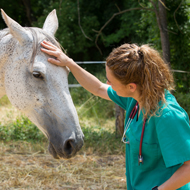Philippine rainforest inhabits a mystery stick insect
A new species of stick insect has been found living on Mount Halcon in the Philippine montane rainforest by scientists.
The insect is wingless, lives on the ground rather than in trees, and has a stout body with short legs - believed to be an adaption to the low-growing vegetation of its habitat. It can release a foul smelling spray when threatened, similar to a skunk, to deter predators, and males are coloured in a unique green-blue and orange pattern.
Scientists say the insect, which has been named Conlephasma enigma, looks different from any other in the world. It has therefore been given its own genus as its relationship to other stick and leaf insects is currently unknown.
The insect's mouthparts, however, are similar to another group of insects that live in tropical America. Scientists would like to know how these two species came to share a similar trait from opposite sides of the world.
Entomologist Oskar Conle gave specimens of a the insect to Marco Gottardo, who is studying a PhD at the University of Siena, Italy, and his colleague Phillip Heller. They have since published details of the discovery in the Competes Rendus Biologies journal.
"We immediately realised that it was something special," said Mr Gottardo. "We hope that the discovery of this particular new insect species may draw attention into the problem of rainforest conservation in the Philippines, which are home to unique and still poorly known wildlife."






 The RCVS has announced a new version of its 1CPD mobile app, with enhanced features for veterinary surgeons and veterinary nurses to record their continuing professional development.
The RCVS has announced a new version of its 1CPD mobile app, with enhanced features for veterinary surgeons and veterinary nurses to record their continuing professional development.
